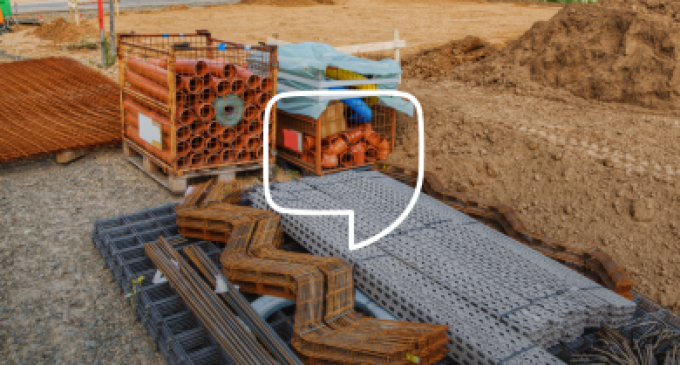The cost of building materials rising – what does that mean for Ireland’s housing crisis?

A PERFECT STORM (literally, in some cases) of factors have conspired to turn up the pressure on Ireland’s housebuilders.
Building sites have reopened, a wave of price inflation has hit construction materials, heaping costs onto builders who are struggling to make up for lost time after a year of intense disruption.
It’s no secret that prices are rising across the board at the moment as demand recovers from the experiences of the past year.
But supply constraints and scarcities of certain materials are also playing a role.
Let’s take a look into why this might be happening…
Inflation
In general, central banks and economists across the world are divided on the issue of inflation and whether it’s here to stay or just a transitory blip on the road to recovery.
But the numbers tell an unambiguous tale.
Inflation hit 1.7% in Ireland in the 12 months to the end of May, according to the latest Consumer Price Index (CPI) from the Central Statistics Office, published earlier this week.
Economists, including those at the ESRI, say that it’s something to keep an eye on but still down the list of issues.
A certain, natural level of inflation was always expected once the economy reopened after the CPI took a sharp dip towards the end of the summer last year.
In fact, prices are yet to return to pre-pandemic levels despite the improvement in Ireland’s economic outlook in the second quarter of the year.
However, another set of CSO figures tells the story of what’s happening in the construction sector specifically.
In each of the first five months of 2021, the cost of building materials rose by an average of 1.3% each month, according to the Wholesale Price Index (WPI).
Although this might seem like small potatoes, it meant that prices across all varieties of goods in this category — including timber, stone, PVS, steel among others — inclined by a steep 5% in the 12 months to the end of May.
Some materials have had steeper rises than others.
The cost of timber, obviously a vital material in pretty much all types of construction, has risen by a whopping 30% while the price of sand and gravel rose by 22% in the year.
PVC pipes and fittings cost an average of 10.5% more than they did last summer.
‘Strong reading’
Demand certainly explains some of the increases.
In June, about a month after most sites fully reopened for the first time since Christmas, Ulster Bank’s purchasing managers’ index (PMI) for the construction sector gave a particularly strong reading.
It suggested that in May, activity in the sector increased at its fastest pace since the PMI began in 2000 on foot of rapid growth in new business and employment.
But “notably,” Ulster Bank chief economist Simon Barry said at the time, “the rate of input cost inflation rose to a new record high in May amid further pressure on supply chains. Higher prices and transportation delays were linked to global material shortages and to Brexit.
“So, as undoubtedly encouraging as the important signs of revival in activity are, this month’s survey also again highlighted that the sector does continue to face some important challenges.”
Supply issues
As Barry hinted at, the Irish construction sector’s struggles aren’t happening in a vacuum.
Over the past 12 months, an unlikely series of mishaps, freak weather events and other strange occurrences have combined with the pandemic to throttle global supply chains.
Everything from microchips to mattresses to chocolate flakes has been affected in some way by what IKEA has called “a global transport crisis”. Even the containers used to ship the goods are in short supply.
Building materials haven’t escaped the international shortage of everything.
For example, a particularly severe storm that hit the American south-east in February literally froze the pipelines of companies that produce the resin materials that go into PVC, creating a scarcity of the material.
Sudden shutdowns and chemical shortages in Europe haven’t helped and that’s largely why the cost of PVC piping has jumped so sharply.
No surprise then that Antrim-based plastics company Brett Martin wrote to its customers in April to tell them that “pipe products will increase with immediate effect by 23%”.
Steel is another problem — across Europe and North America, a shortage of the alloy has choked businesses for the best part of a year now.
In fact, benchmark steel prices have risen by 200% in the US in the 12 months, mainly due to production shutdowns during the pandemic. Europe is facing a similar issue that’s only been exacerbated, some say, by EU safeguard quotas on imports of steel introduced in 2019.
Brexit-related delays at ports also fed into the difficulty early in the year although there are signs that those teething problems are abating as the new processes bed in.
There’s plenty of problems on the home front as well.
While the price of global timber has risen dramatically since the start of the pandemic, domestic supplies have also been constrained.
Although Ireland is a net exporter of wood, delays in the processing of tree-felling licenses have left the economy increasingly reliant on imports.
Low output
So are these increases starting to feed into house prices in Ireland?
It’s certainly possible.
After all, according to estate agents DNG, house prices have risen nationally by 7.9% on average during the first six months of the year, the fastest rate since 2017
A recent survey of builders conducted by the Irish Home Builders Association (IHBA) suggests that the industry is concerned about the impact of inflation on the affordability of homes.
IHBA director James Benson put it as plainly as possible last month when he said, “These increased costs will have to be taken on by either the buyer or the builder.”
But economists like Mark Cassidy, Director of Statistics and Economics at the Central Bank of Ireland, are cooler on the notion that higher input costs are rocket-fuelling house prices all on their own.
“Higher building costs, higher raw materials are exacerbating the problem at the moment,” he told reporters last week.
“The problem at the moment is that we have seen that demand [for houses] has remained stronger than many people suggested.
“I think undoubtedly the main effect relates to a lack of supply… mainly it’s the low output compared to demand.”
Reference: The Journal







